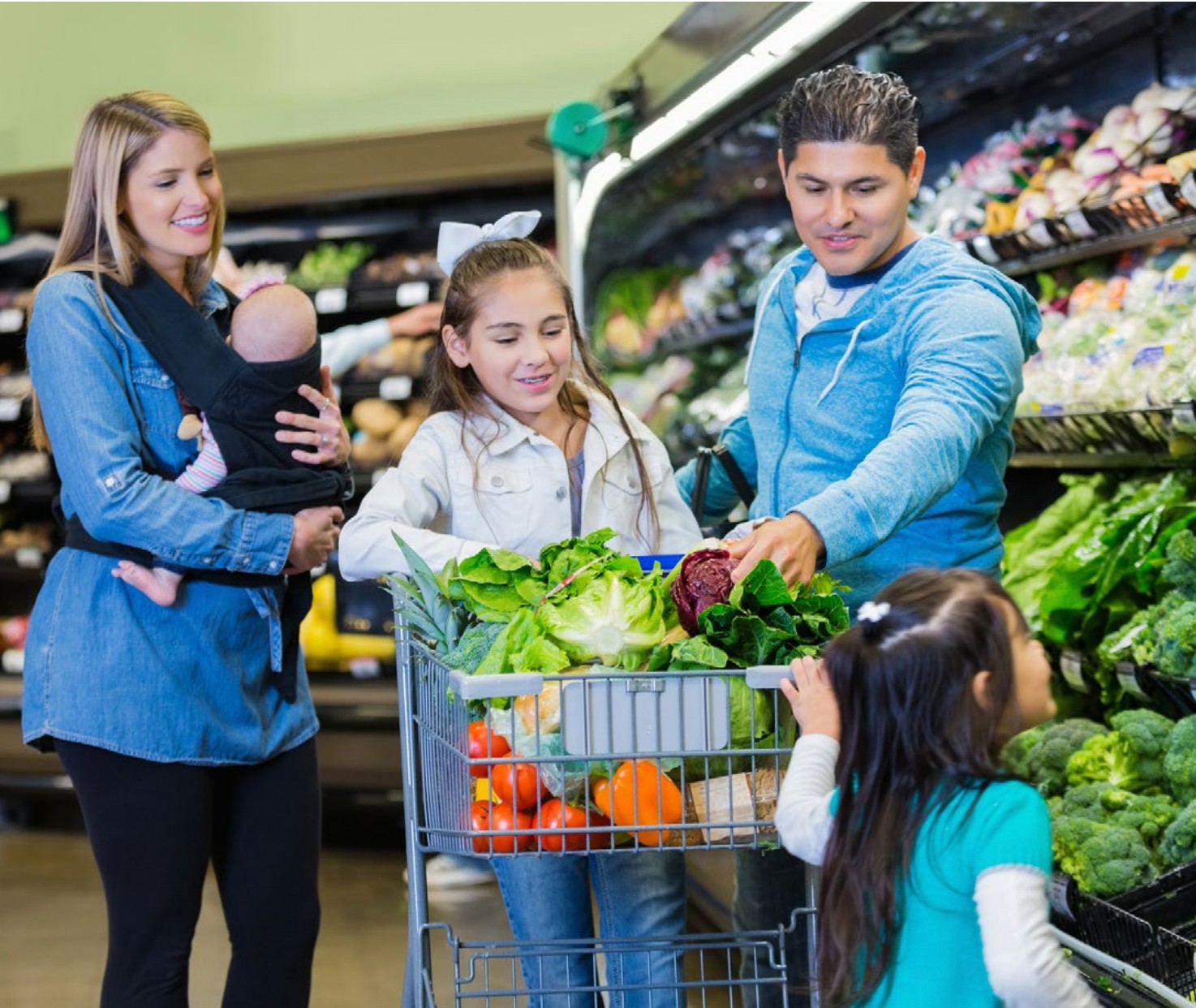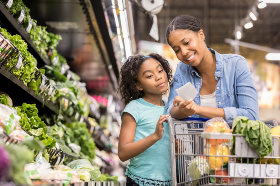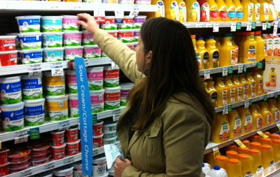By providing monthly benefits to eligible low-income people to purchase food, the Supplemental Nutrition Assistance Program (SNAP) plays a critical role in reducing hunger, malnutrition, and poverty, and improving family security, child and adult health, employment, and other outcomes.

Protect and Strengthen SNAP by Preserving Consumer Choice
Congress must adhere to bipartisan and public support to preserve consumer choice for the Supplemental Nutrition Assistance Program (SNAP) in the FY 2024 Agriculture Appropriations Bill, the upcoming Farm Bill, and any other legislative vehicles. Learn more about preserving consumer choice in SNAP in FRAC’s latest-one pager.

Continuing the Thrifty Food Plan Adjustment Is Good for Everyone
The bipartisan 2018 Farm Bill directed USDA to update the Thrifty Food Plan. The resulting update in 2021 was the first in the plan’s history and led to a necessary and long overdue increase in SNAP benefits. Learn why the Thrifty Food Plan adjustment should be protected from efforts to eliminate or weaken it in the 2024 Farm Bill and in other legislation in FRAC’s new one-pager, Continuing the Thrifty Food Plan Adjustment Is Good for Everyone.

Food Fuels Futures: Expanded SNAP Eligibility Reduces Hunger Among College Students
FRAC’s Food Fuels Futures: Expanded SNAP Eligibility Reduces Hunger Among College Students research brief — informed by interviews with college students — sets forth reasons why SNAP student eligibility expansions in response to the COVID-19 pandemic were so vital to college students and why decision-makers should build on these lessons and eliminate the “work-to-eat rule” so that more college students can focus on learning rather than being distracted by hunger.

SNAP Benefit Adequacy
The monthly benefits provided by SNAP enhance the food purchasing power of eligible low-income individuals and families. However, the greatest shortcoming of SNAP is that benefits for most households are not enough to get through the entire month without hunger or being forced to sacrifice nutrition quality.

Closing the SNAP Gap
The “SNAP Gap” is the gap between those eligible to enroll in SNAP and those actively enrolled in SNAP. FRAC and partners have conducted research in multiple regions, states, and cities to identify strategies to close the SNAP Gap.

Disaster Relief Resources
The federal nutrition programs are dynamic near-term responders in the wake of natural disasters. Find out more with FRAC’s extensive Disaster-SNAP and related resources.

Food Research & Action Center’s Transition Recommendations: “This is the Time to Heal in America,” and It Begins With Addressing Hunger
FRAC’s transition recommendations provide a roadmap for the Biden-Harris Administration to address hunger in America. It sets forth the harms of food insecurity, summarizes the strengths of the federal nutrition programs, and concludes with high-priority recommendations for administrative and legislative asks that need to be taken to reduce hunger and poverty.
COVID-19 Resources
- FRAC ResourcesPandemic EBT FAQ
Learn more about Pandemic Electronic Benefit Transfer eligibility and states’ implementation of this program.Why the Administration and Congress Need to Build on SNAP Down Payments Now
FRAC Chat blog clarifying the USDA’s emergency benefit announcement and FRAC’s congressional ask for the SNAP 15 percent boost to maximum allotments.Pandemic EBT
Guidance from FRAC that summarizes and offers considerations for implementing Pandemic Electronic Benefit Transfer (P-EBT). The Families First Coronavirus Response Act creates the P-EBT program, an important opportunity to provide nutritional resources to families who are losing access to free or reduced-price school meals as school across the country close in response to COVID-19.An Advocate’s Guide to the Disaster Supplemental Nutrition Assistance Program (D-SNAP)
Learn how D-SNAP works and what advocates, elected officials, and service providers can do to reduce hunger and food insecurity before, during, and after a disaster. - USDA Waivers
SNAP – Periodic Report Flexibility for Non-Extended Recertification Cases
USDA updated information on approvals and denials of certain SNAP application processing waivers
SNAP Emergency Allotments to Current SNAP Households
The USDA grants states waivers to issue SNAP emergency allotments bringing households’ benefit amounts up to the maximum benefit for their household size.USDA blanket approval for states to adjust SNAP interview requirements
- USDA GuidanceSNAP benefit levels for January through June 2021
Month-to-Month Continuation of Emergency SNAP benefits
SNAP COVID-19 Emergency Allotments Guidance
Guidance from the USDA Food and Nutrition Service (FNS) regarding SNAP state agencies on implementing emergency SNAP allotments pursuant to H.R. 6201USDA FNS Memorandum SNAP Questions and Answers, COVID-19, Set #1
State-by-state list of SNAP EBT contractors (March 2020)
SNAP Guidance on Time Limits for Recipients Currently Enrolled
Guidance from the USDA Food and Nutrition Service (FNS) regarding SNAP state agencies on current status of SNAP time limits pursuant to H.R. 6201SNAP Pandemic Planning Guidelines
Learn how State agencies can work within their agency and with State-level pandemic planning authorities to update their pandemic plans. - College Student SNAP AccessEducation Department Highlights New SNAP Access for College Students During COVID
- LitigationSeptember 11, 2020 press release: “Federal Court Issues Order Stopping USDA from Denying Emergency SNAP Benefits to the Poorest Pennsylvanians,” from Community Legal Services of Philadelphia and Morgan, Lewis & Bockius
September 11, 2020 ruling: Federal court enjoins USDA from denying Pennsylvania requests to include SNAP households already at the maximum benefit level among those to receive Emergency SNAP payments. Opinion and Order.
- Online PurchasingOnline Purchasing Pilot approved states: AL, AZ, CA, CO, CT, DC, DE, FL, GA, IA, ID, IL, IN, KS, KY, MA, MD, MI, MN, MO, MS, NH, NJ, NM, NC, NE, NV, NY, OH, OK, OR, PA, RI, SC, SD, TN, TX, UT, VA, VT, WA, WI
The online purchasing pilot initially began in AL, FL, IA, NE, NY, OR, WA. Arizona and California were approved April 8, 2020. Florida and Idaho were approved April 11, 2020. District of Columbia., and North Carolina were approved April 17, 2020. Kentucky, Missouri, and Texas were approved April 21, 2020. Vermont was approved April 24, 2020. Minnesota was approved May 1, 2020. Nevada was approved May 4, 2020. Colorado was approved May 6, 2020. New Mexico was approved May 7, 2020. Rhode Island was approved May 8, 2020. Wisconsin was approved May 11, 2020. Connecticut, Georgia, Illinois, Indiana, Maryland, Massachusetts, Michigan, New Jersey, Ohio, Oklahoma, Pennsylvania, Tennessee and Virginia were approved May 20, 2020. New Hampshire was approved June 3, 2020. South Dakota was approved June 5, 2020. Delaware and Mississippi were approved June 10, 2020. South Carolina and Utah were approved June 16, 2020. Kansas was approved June 23, 2020.FMI — The Food Industry Association Blog Post: It’s A “SNAP” To Order Online and Pay At Store
FMI — The Food Industry Association blog regarding “click, collect and pay” options for grocery access for SNAP shoppers. - SNAP Outreach ResourcesHunger Solutions New York SNAP Outreach Resources
SNAP COVID-19 Special Outreach Campaign Companion
General SNAP Flyer Template
SNAP Lost Work Flyer
SNAP Senior FlyerFMI – The Food Industry Association Feeding Assistance Toolkit
Outreach Flyer on SNAP Emergency Payments
Volante de divulgación sobre pagos de emergencia en SNAP - Letters from FRAC and PartnersAugust 12, 2020 letter from FRAC, Community Catalyst, National Low Income Housing Coalition, and Service Employees International Union (SEIU) calling for a comprehensive COVID-19 relief bill.
June 18, 2020 letter from nearly 2,500 organizations urging the Senate to boost SNAP benefits to protect individuals and communities against hardship and jump-start a strong economic recovery.
May 28, 2020 letter from the Sustainable Food Policy Alliance (SFPA), including Danone North America, Mars Incorporated, Nestlé USA, and Unilever United States, urging Congressional leadership to provide a temporary increase in SNAP benefits in the next coronavirus relief legislation, along with other measures that would boost nutrition-related resources.
Utilizing Restaurants to Get Food to SNAP Participants
A letter to USDA Secretary Perdue asking him to promote the Restaurant Meals Program so people are aware they can use their TANF and SNAP EBT funds through this program. The letter is signed by FRAC, the International Foodservice Distributors Association, the National Council of Chain Restaurants, the National Restaurant Associate, and the Western Center on Law & Poverty.AARP Letter
A letter to Congress from the AARP asking to strengthen Federal Nutrition Programs among other programs in response to COVID-19. - Letters from Federal and State Policymakers and AdministratorsAugust 27, 2020 letter from the Pennsylvania Human Services Department leader urging Congress to boost SNAP benefits.
September 8, 2020 American Public Human Services Association (APHSA) issued a special statement about investing resources in nutrition and other human services for a strong and equitable economic recovery.
August 7, 2020 letter from American Public Human Services Association (APHSA) to Congress in support of SNAP boosts, Pandemic EBT (P-EBT) and program flexibilities” to ensure families impacted by the pandemic can put food on the table.”
August 7, 2020 letter from National Association of Counties (NACo) and the National Association of County Human Services Administrators (NACHSA) in support of H.R. 7794 to extend current SNAP flexibilities as COVID-19 continues.
July 27, 2020 press release on legislation to extend SNAP waiver flexibility introduced by Reps. Marcia L. Fudge (D-OH), Jim McGovern (D-MA), Alma Adams (D-NC), Jahana Hayes (D-CT), Kim Shrier (D-WA), Al Lawson, Jr. (D-FL) and Jimmy Panetta (D-CA).
July 27, 2020 letter from the American Public Human Services Association (APHSA) issued a statement explaining the importance of granting state SNAP agencies flexibility for processing applications and accommodating social distancing.
July 22, 2020 letter from Kansas Governor Laura Kelly in support of boosting SNAP benefits.
July 21, 2020 letter from Senator Deb Fisher (R-NE) demanding boosts to SNAP benefits.
July 1, 2020 letter from Reps. Marcia L. Fudge (OH), Barbara Lee (CA), and John Katko (NY) delivered a letter to Congressional leaders urging an increase in Supplemental Nutrition Assistance Program (SNAP) to address rising food insecurity and unprecedented demand at food banks across the country.
June 1, 2020 letter from 25 state attorneys general urging Congress to include provisions in the next coronavirus stimulus package that would prohibit the use of funds to finalize or implement three administrative rules that would restrict Americans’ ability to receive critically necessary SNAP benefits.
May 6, 2020 letter from Maryland delegation in support of SNAP in the next COVID-19 relief package.
May 5, 2020 letter from Wisconsin Senator Baldwin, Congresswoman Moore, Congressman Kind, and Congressman Pocan in support of SNAP in the next COVID-19 relief package.
April 29, 2020 letter from 22 Senators led by Democratic Senators Merkely (OR) and Murphy (CT) urging Senate leaders to boost SNAP benefits.
April 28, 2020 letter from Congressman Panetta, Senator Murphy announce legislation to expand access to Restaurant Meals Program amid COVID-19.
April 27, 2020 letter from Senators Murphy (D-CT), Hirono (D-HI), Harris (D-CA) and Warren (D-MA) urging USDA to allow college students unemployed due to COVID-19 access to SNAP.
April 21, 2020 letter from bipartisan National Governors Association calling for 15 percent increase to maximum SNAP benefit and other relief.
April 16, 2020 a letter from two Senators and nine Representatives from New Jersey asking Congressional leaders to bolster SNAP benefits as a legislative priority.
April 16, 2020 letter from Colorado Governor Jared Polis (D) and Senators Michael Bennet (D) and Cory Gardner (R) wrote their own on how increasing SNAP benefits will help their state.
April 13, 2020 joint statement from House Speaker Nancy Pelosi and Senate Democratic Leader Chuck Schumer that included boosting SNAP as an urgent priority in an interim emergency coronavirus relief package. This follows their joint statement on April 8, which listed a “15 percent increase to the maximum SNAP benefit to help put food on the table” among the top priorities.
April 9, 2020 Congressional Progressive Caucus wrote a letter to Speaker of the House Nancy Pelosi detailing their priorities for the fourth Congressional relief package, including strengthening SNAP.
April 6, 2020 House letter led Reps. Jim McGovern (D-MA), Marcia Fudge (D-OH), Rosa DeLauro (D-CT) and Ayanna Pressley (D-MA) and signed by 136 of their colleagues urging House and Senate leaders to prioritize anti-hunger efforts and strengthen SNAP in the next COVID-19 legislative relief package.

SNAP data by congressional district–updated with FY 2018 characteristics
Explore These Topics
- Quick Facts
- SNAP helped lift 3.2 million Americans out of poverty in 2018.
- According to recent studies, it is estimated that each dollar in federally funded SNAP benefits during a recession generates between $1.50 and $1.80 in economic activity. SNAP is targeted to go to the lowest-income people in our country.
- The federal government pays 100 percent of SNAP benefits. Federal and state governments share administrative costs (with the federal government contributing nearly 50 percent).
- SNAP is the largest nutrition assistance program administered by the U.S. Department of Agriculture. SNAP was previously named the Food Stamp Program until Oct. 1, 2008.
- Every five years, SNAP is reauthorized by Congress as part of the Farm Bill. The reauthorization establishes who is eligible for SNAP and addresses program access, benefit levels, and other matters. Find out more…
- FRAC ResourcesGet FRAC reports, graphics, and more.
- SNAP’s StrengthsSNAP is the largest nutrition assistance program administered by the U.S. Department of Agriculture. It serves as the first line of defense against hunger. In fact, without SNAP, hunger in this country would be far, far worse. Here are the reasons why we need to urge policymakers to protect and strengthen this effective program:
- SNAP reduces hunger and food insecurity by providing very low-income people desperately needed, targeted assistance to purchase food at grocery stores, farmers’ markets, and other regular commercial food outlets, through an effective and efficient Electronic Benefit Transfer (EBT) system.
- Because SNAP benefits are so urgently needed by families, they are spent quickly — 97 percent of benefits are redeemed by the end of the month of issuance — thereby bolstering local economies.
- According to estimates issued by USDA and others, each $1 in SNAP benefits during an economic downturn generates between $1.50-1.80. SNAP is targeted to go to the lowest-income people in our country. This includes millions of working poor families.
- SNAP reaches key vulnerable populations — 81 percent of SNAP households include a child, an elderly person, or a person with disabilities; 86 percent of all SNAP benefits go to such households. While losing a job is the most common event causing a household to seek SNAP, 53 percent of SNAP households with children in fiscal year 2019 worked and had earnings; only 10 percent of SNAP households with children received TANF.
- Research has found that receipt of SNAP in early childhood improved high school graduation rates, adult earnings, and adult health.
- When the national, regional, state, or local area economy is in trouble, SNAP is among the most effective government responses. SNAP reacts quickly and robustly to economic problems. This has been seen most clearly and dramatically at the start of the recession in 2008, when millions of people became newly unemployed or underemployed. The program responded quickly to provide desperately needed help in the downturn. Accordingly, SNAP caseload and spending is declining as the economy slowly improves.
- SNAP lifted 2.5 million Americans out of poverty in 2019, according to the Census Bureau’s Supplemental Poverty Measure.
- SNAP is nearly as effective as the Earned Income Tax Credit in lifting families above the poverty line, and far more effective than any other program in lifting families out of deep poverty.
- SNAP relieves pressure on overwhelmed food banks, pantries, religious congregations, and other emergency food providers across the country. They recognize the comprehensive approach needed to end hunger and see SNAP as the cornerstone of national, state, and local anti-hunger efforts, and are the first to note their inability to meet added demand that would come from weakening SNAP.
- Take FRAC's SNAP ChallengeThe SNAP Challenge is a way to gain a personal understanding and raise awareness of what it means to struggle against hunger. Participants spend a week living on the average daily SNAP benefit (about $4 per day) and share their experiences about the difficult choices they have to make. Check out our SNAP Challenge Toolkit.



